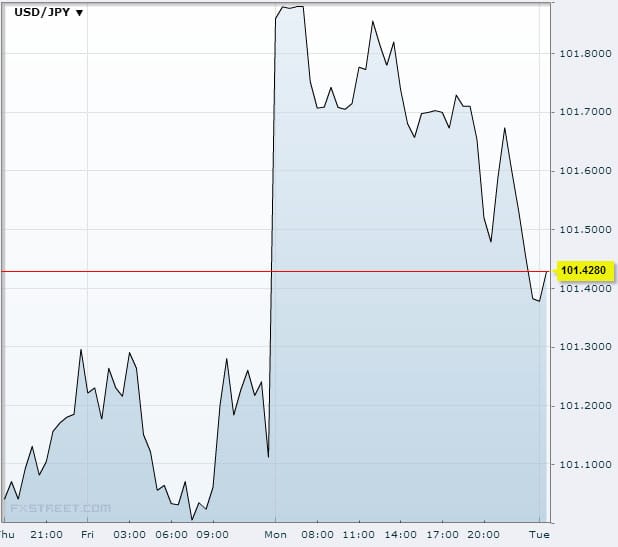The historic deal struck between the US and Iran on the weekend, in which the US agreed to ease sanctions in exchange for an end to some of Iran’s more sensitive nuclear activities, boosted the markets yesterday. Stock markets rose across the board, and the increased appetite for risk saw demand for the safe-haven Japanese yen tumble.

Source: fxstreet.com
Immediately after trading commenced on Monday morning, the yen fell to a six-month low against the US dollar and a four-year low against the euro. The thawing of relations between the previously hostile Middle East country and the West, although tentative, has reduced the risk of oil price spikes, making risky investments more attractive. In times such as these, investors often sell the low-yielding yen in search of assets such as equities, which offer greater returns.
Having hit a peak of 101.91 yen at the opening of trading, the dollar was on a downtrend for the rest of the day as the market corrected itself, although it remains well above the Friday close. There is much speculation among traders that the yen could weaken further, with the volume of bets against the currency at the highest level for six years in the last week.
“The pair continues to gather momentum and despite showing clear signs of being overbought remains on path to test the yearly highs as long as U.S. data is supportive,” said BK Asset Management’s Boris Schlossberg.
With the yen tending in recent times to have an inverse correlation with the Japanese stock market, the recent rally in the Nikkei has been exerting a strong downward force on the currency. A weaker currency is good news for Japanese exporters, and as a major oil importer, the likelihood of cheaper oil is also likely to drive Japanese stocks upward. The Nikkei average has gained almost 11% in the past two weeks.
The euro also gained against the yen, climbing to a four-year high of 137.98 yen before falling to 137.16, where it remained for much of the rest of the day. Meanwhile, the euro fell 0.3% against the dollar to $1.3515 after ECB Governing Council Member Ardo Hansson said that more interest rate cuts were a possibility. Lower oil prices could make concerns about deflation in the eurozone even more acute.
The dollar took a brief knock after the release of the Existing Home Sales report, which saw the fifth decrease in a row to a 10-month low.
The drop in oil prices hit commodity currencies, particularly the oil-sensitive Canadian dollar, against which the US dollar rose 0.4% to CAD 1.0549. The Australian dollar was down 0.1 percent at $0.9159, having earlier hit a 2-1/2 month low of $0.9117 in the wake of the Reserve Bank of Australia’s threat to intervene in the currency markets.
Tradersdna is a leading digital and social media platform for traders and investors. Tradersdna offers premiere resources for trading and investing education, digital resources for personal finance, market analysis and free trading guides. More about TradersDNA Features: What Does It Take to Become an Aggressive Trader? | Everything You Need to Know About White Label Trading Software | Advantages of Automated Forex Trading



































